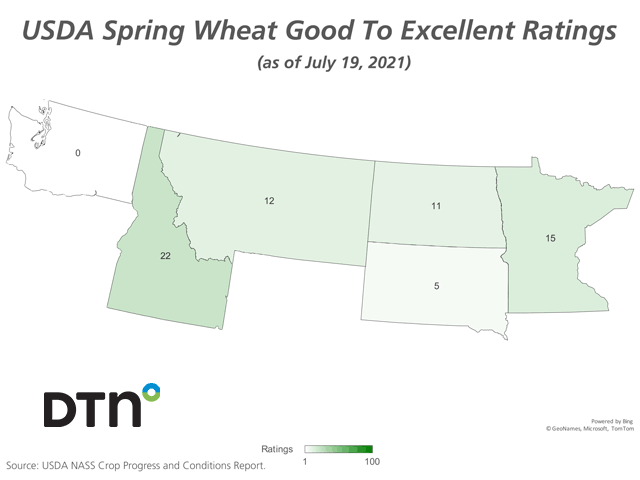USDA Crop Progress Report
Rains Benefit Crops in East, While Crop Conditions Continue to Deteriorate in West
This article was originally posted at 3:04 p.m. CDT on Monday, July 19. It was last updated at 4:14 p.m. CDT on Monday, July 19.
**
OMAHA (DTN) -- Plentiful rains in Eastern and Southern parts of the U.S. helped crop conditions remain steady to slightly higher nationwide last week, balancing out further deteriorating conditions in Northern and Western parts of the country, USDA NASS said in its weekly Crop Progress report on Monday.
After rising 1 percentage point the previous week, corn condition held steady at 65% good to excellent last week, according to NASS. The current rating is the same as this time in 2017.
"Nebraska and Wisconsin corn continues to be highly rated at 78% and 76%, respectively," said DTN Senior Analyst Dana Mantini. "Iowa corn is rated 68% good to excellent, and Illinois is rated 65% good to excellent. North and South Dakota remain poor at 29% and 30% good to excellent, respectively."
Corn silking progress jumped considerably last week, moving ahead 30 percentage points from 26% on Sunday, July 11, to 56% on Sunday, July 18. That puts the current silking pace 4 percentage points ahead of the five-year average of 52%. Corn in the dough stage was also running slightly ahead of normal at 8% compared to the average of 7%.
Development of the soybean crop was running slightly ahead of the average pace, too. NASS estimated that 63% of the crop was blooming as of Sunday, 6 percentage points ahead of the five-year average of 57%. Soybeans setting pods was pegged at 23%, 2 percentage points ahead of the five-year average of 21%.
P[L1] D[0x0] M[300x250] OOP[F] ADUNIT[] T[]
Soybean condition rose slightly for the first time in several weeks last week, up 1 percentage point from 59% good to excellent on July 11 to 60% on July 18. However, that is still the third-lowest good-to-excellent rating in 12 years.
"Once again, Nebraska soybeans are highly rated at 81% good to excellent, with Iowa and Illinois at 66% and 60%, respectively," Mantini said. "The Dakotas remain poorly rated, with North Dakota at 20% good to excellent and South Dakota at 29% good to excellent, with a bit less than one-third of the crop rated as very poor to poor in South Dakota and 41% very poor to poor in North Dakota."
After holding steady the previous week, the condition of the spring wheat crop resumed its freefall last week as the Northern and Western U.S. continued to bake in hot, dry weather. The condition of spring wheat fell another 5 percentage points last week to reach a good-to-excellent rating of just 11%, still the lowest good-to-excellent rating for the crop since 1988. Sixty-three percent of the spring wheat crop is now rated either very poor or poor.
"The good-to-excellent rating for spring wheat in Minnesota fell 13 percentage points last week to 15%, while North Dakota's rating dropped 5 percentage points to 11%," said DTN Lead Analyst Todd Hultman.
Ninety-two percent of the spring wheat crop was headed, equal to the five-year average.
Meanwhile, winter wheat harvest had nearly caught up to the average pace by the end of last week, reaching 73% complete as of Sunday compared to the five-year average of 74%.
"Kansas winter wheat is 96% harvested, and Illinois is 97% harvested," Hultman said. "Indiana and Ohio are 5 percentage points below their average paces for this time of year."
The following are some other highlights from this week's Crop Progress report:
Sorghum headed was 33%, 1 percentage point behind average. Sorghum coloring was pegged at 17%, 2 percentage points behind average. Sorghum condition was rated 68% good to excellent, down 2 percentage points.
Cotton squaring was 69%, 6 percentage points behind average. Cotton setting bolls was 23%, 7 percentage points behind the average pace of 30%. Cotton condition was rated 60% good to excellent, up 4 percentage points from the previous week.
Rice was 30% headed, 6 percentage points behind the average pace. Rice condition was rated 72% good to excellent, up 1 percentage point from the previous week.
Oats headed was at 98%, and 18% of the crop was harvested. Oats were rated 35% in good-to-excellent condition, unchanged from the previous week. Barley was 90% headed, equal to the five-year average. Barley condition was rated 27% good to excellent, up 3 percentage points from the previous week.
**
To view weekly crop progress reports issued by National Ag Statistics Service offices in individual states, visit http://www.nass.usda.gov/…. Look for the U.S. map in the "Find Data and Reports by" section and choose the state you wish to view in the drop-down menu. Then look for that state's "Crop Progress & Condition" report.
| National Crop Progress Summary | ||||
| This | Last | Last | 5-Year | |
| Week | Week | Year | Avg. | |
| Corn Silking | 56 | 26 | 55 | 52 |
| Corn Dough | 8 | 3 | 8 | 7 |
| Soybeans Blooming | 63 | 46 | 62 | 57 |
| Soybeans Setting Pods | 23 | 10 | 23 | 21 |
| Cotton Squaring | 69 | 55 | 72 | 73 |
| Cotton Setting Bolls | 23 | 16 | 26 | 30 |
| Winter Wheat Harvested | 73 | 59 | 73 | 74 |
| Spring Wheat Headed | 92 | 83 | 89 | 92 |
| Sorghum Headed | 33 | 29 | 33 | 34 |
| Sorghum Coloring | 17 | 15 | 18 | 19 |
| Oats Headed | 98 | 94 | 96 | 96 |
| Oats Harvested | 18 | 11 | 19 | 18 |
| Barley Headed | 90 | 78 | 86 | 90 |
| Rice Headed | 30 | 21 | 31 | 36 |
**
| National Crop Condition Summary | |||||||||||||||||
| (VP=Very Poor; P=Poor; F=Fair; G=Good; E=Excellent) | |||||||||||||||||
| This Week | Last Week | Last Year | |||||||||||||||
| VP | P | F | G | E | VP | P | F | G | E | VP | P | F | G | E | |||
| Corn | 2 | 7 | 26 | 50 | 15 | 2 | 6 | 27 | 51 | 14 | 2 | 6 | 23 | 52 | 17 | ||
| Soybeans | 3 | 8 | 29 | 49 | 11 | 3 | 8 | 30 | 49 | 10 | 2 | 5 | 24 | 54 | 15 | ||
| Spring Wheat | 29 | 34 | 26 | 10 | 1 | 21 | 34 | 29 | 15 | 1 | 2 | 5 | 25 | 55 | 13 | ||
| Cotton | 2 | 7 | 31 | 49 | 11 | 1 | 8 | 35 | 44 | 12 | 5 | 17 | 31 | 39 | 8 | ||
| Sorghum | 1 | 5 | 26 | 57 | 11 | 1 | 4 | 25 | 57 | 13 | 3 | 9 | 37 | 43 | 8 | ||
| Oats | 9 | 21 | 35 | 29 | 6 | 11 | 21 | 33 | 30 | 5 | 2 | 8 | 29 | 52 | 9 | ||
| Barley | 17 | 25 | 31 | 23 | 4 | 16 | 27 | 33 | 20 | 4 | - | 4 | 21 | 48 | 27 | ||
| Rice | 1 | 3 | 24 | 55 | 17 | 1 | 4 | 24 | 55 | 16 | - | 3 | 24 | 57 | 16 | ||
Anthony Greder can be reached at Anthony.greder@dtn.com
Follow him on Twitter @AGrederDTN
(c) Copyright 2021 DTN, LLC. All rights reserved.




